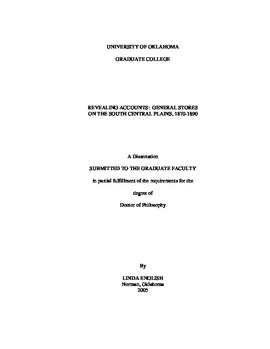| dc.contributor.advisor | Hurtado, Albert L., | en_US |
| dc.contributor.author | English, Linda. | en_US |
| dc.date.accessioned | 2013-08-16T12:19:42Z | |
| dc.date.available | 2013-08-16T12:19:42Z | |
| dc.date.issued | 2005 | en_US |
| dc.identifier.uri | https://hdl.handle.net/11244/843 | |
| dc.description.abstract | This study also places Texas and Indian Territory into the larger context of late nineteenth-century America, arguing the prevailing value systems and cultural dispositions of the late nineteenth century transcended regional boundaries. The topics addressed in this work extend far beyond the local into broader national issues, including Reconstruction, racism, immigration, domesticity, Glided-Age acquisitiveness, Victorianism, temperance, regionalism, and consumerism. In effect, this study employs ledgers, daybooks, and account records as a means for studying the larger social and cultural issues of the last decades of the nineteenth century. As a record of consumption, such records shed light on the material possessions, dispositions, assumptions, values, and experiences in short, the culture of the thousands of persons recorded on pages now yellowing with age. | en_US |
| dc.description.abstract | This dissertation uses the valuable and untapped resource of general store ledgers to examine consumption practices and consumer behavior on the south central plains in the 1870s and 1880s, specifically the regions of Texas and Indian Territory. Of particular interest is the ways in which class, gender, race, and ethnicity shaped commercial relations during the period. Store records indicate, for example, that class, gender, and race distinctions were determined and reinforced on a day-to-day basis during commercial transactions carried out at general stores. Merchants played a privileged role in dictating the terms on which different groups entered the market place, particularly women and racial minorities. In this predominantly rural region, farmers relied on the credit offered by merchants to make purchases at general stores. Due to the vagaries of the market and the impact of competition, merchants were similarly dependent on their clients for their economic well being significant in part because the majority of store owners were white men, while their customer base in this region proved to be a far more heterogeneous group. As local gathering sites, stores (and specifically store records) provide precious access into the social dynamics of the communities in which they operated. Few other local institutions can make such a claim. | en_US |
| dc.format.extent | vi, 250 leaves ; | en_US |
| dc.subject | Texas Hill Country (Tex.) Social conditions 19th century. | en_US |
| dc.subject | Texas Social conditions 19th century. | en_US |
| dc.subject | General stores Social aspects Oklahoma history 19th century. | en_US |
| dc.subject | Account books Social aspects Oklahoma history 19th century. | en_US |
| dc.subject | History, United States. | en_US |
| dc.subject | Texas Social life and customs 19th century. | en_US |
| dc.subject | General stores Social aspects Texas history 19th century. | en_US |
| dc.subject | Oklahoma Social conditions 19th century. | en_US |
| dc.subject | Oklahoma Social life and customs 19th century. | en_US |
| dc.subject | Account books Social aspects Texas history 19th century. | en_US |
| dc.subject | Texas Hill Country (Tex.) Social life and customs 19th century. | en_US |
| dc.title | Revealing accounts: General stores on the south central plains, 1870--1890. | en_US |
| dc.type | Thesis | en_US |
| dc.thesis.degree | Ph.D. | en_US |
| dc.thesis.degreeDiscipline | Department of History | en_US |
| dc.note | Source: Dissertation Abstracts International, Volume: 66-01, Section: A, page: 0310. | en_US |
| dc.note | Adviser: Albert L. Hurtado. | en_US |
| ou.identifier | (UMI)AAI3162837 | en_US |
| ou.group | College of Arts and Sciences::Department of History | |
